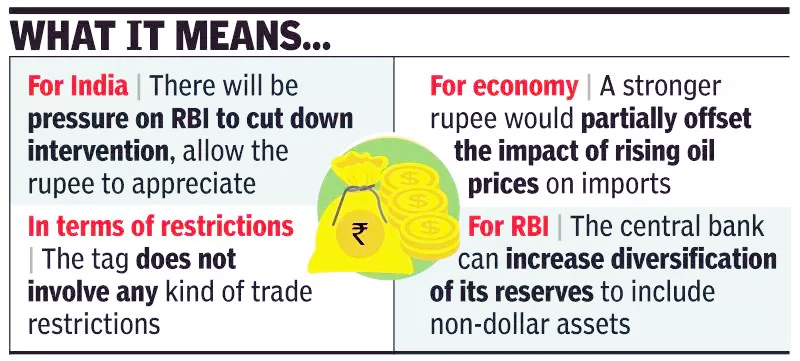US Puts India on Currency Watchlist | 17 Dec 2020
Why in News
Recently, the US treasury has placed India on its currency manipulator watch list. Vietnam and Switzerland have been labelled as currency manipulators.
- In 2019, the US Treasury Department had removed India from its currency manipulator watch list of major trading partners.
Key Points
- Currency Manipulators:
- This is a label given by the US government to countries it feels are engaging in “unfair currency practices” by deliberately devaluing their currency against the dollar.
- The practice would mean that the country in question is artificially lowering the value of its currency to gain an unfair advantage over others. This is because the devaluation would reduce the cost of exports from that country and artificially show a reduction in trade deficits as a result.
- Currency Manipulator Watch List:
- The US Department of Treasury releases the semi-annual report where it has to track developments in international economies and inspect foreign exchange rates.
- Criteria: An economy meeting two of the three criteria in the Trade Facilitation and Trade Enforcement Act of 2015 is placed on the Watch List. This includes:
- A “significant” bilateral trade surplus with the US — one that is at least USD 20 billion over a 12-month period.
- A material current account surplus equivalent to at least 2% of gross domestic product (GDP) over a 12-month period.
- “Persistent”, one-sided intervention — when net purchases of foreign currency totalling at least 2% of the country’s GDP over a 12 month period are conducted repeatedly, in at least six out of 12 months.
- Consequence: Inclusion in the list does not subject to any kind of penalty and sanctions but it deteriorates the global financial image of the country in the financial markets in terms of foreign exchange policies including undervaluation of currencies to gain export advantages.
- India’s Status:
- India, Taiwan and Thailand have been added to seven others already in the watch list.
- Others on the list include China, Japan, Korea, Germany, Italy, Singapore and Malaysia.
- As per the report by the US Treasury, India and Singapore had intervened in the foreign exchange market in a "sustained, asymmetric manner" but did not meet other requirements to warrant designation as manipulators.
- India, which has for several years maintained a “significant” bilateral goods trade surplus with the US, crossed the USD 20 billion mark, according to the latest report.
- Bilateral goods trade surplus totalled USD 22 billion in the first four quarters through June 2020.
- Further, India’s net purchases of foreign exchange accelerated notably in the second half of 2019. Following sales during the initial onset of the pandemic, India sustained net purchases for much of the first half of 2020, which pushed net purchases of foreign exchange to USD 64 billion–or 2.4% of GDP–over the four quarters through June 2020.
- According to some experts, the tag could lead to the rupee appreciating as the Reserve Bank of India (RBI) might step back from its dollar purchases.
- Currency appreciation is an increase in the value of one currency in relation to another currency. A currency is strong if it is becoming more valuable relative to another country’s currency.
- India, Taiwan and Thailand have been added to seven others already in the watch list.

